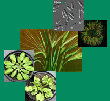| Sasidharan, R; Bailey-Serres, J; et al., ; Mustroph, A; et al., ; Voesenek, LACJ: Community recommendations on terminology and procedures used in flooding and low oxygen stress research, New Phytologist, 214(4), 1403-1407 (2017), doi:10.1111/nph.14519 | |
| Abstract: Apart from playing a key role in important biochemical reactions, molecular oxygen (O2) and its by-products also have crucial signaling roles in shaping plant developmental programs and environmental responses. Even under normal conditions, sharp O2 gradients can occur within the plant when cellular O2 demand exceeds supply, especially in dense organs such as tubers, seeds and fruits. Spatial and temporal variations in O2 concentrations are important cues for plants to modulate development (van Dongen & Licausi, 2015; Considine et al., 2016). Environmental conditions can also expand the low O2 regions within the plant. For example, excessive rainfall can lead to partial or complete plant submergence resulting in O2 deficiency in the root or the entire plant (Voesenek & Bailey-Serres, 2015). Climate change-associated increases in precipitation events have made flooding a major abiotic stress threatening crop production and food sustainability. This increased flooding and associated crop losses highlight the urgency of understanding plant flooding responses and tolerance mechanisms. Timely manifestation of physiological and morphological changes triggering developmental adjustments or flooding survival strategies requires accurate sensing of O2 levels. Despite progress in understanding how plants sense and respond to changes in intracellular O2 concentrations (van Dongen & Licausi, 2015), several questions remain unanswered due to a lack of high resolution tools to accurately and noninvasively monitor (sub)cellular O2 concentrations. In the absence of such tools, it is therefore critical for researchers in the field to be aware of how experimental conditions can influence plant O2 levels, and thus on the importance of accurately reporting specific experimental details. This also requires a consensus on the definition of frequently used terms. At the 15th New Phytologist Workshop on Flooding stress (Voesenek et al., 2016), community members discussed and agreed on unified nomenclature and standard norms for low O2 and flooding stress research. This consensus on terminology and experimental guidelines is presented here. We expect that these norms will facilitate more effective interpretation, comparison and reproducibility of research in this field. We also highlight the current challenges in noninvasively monitoring and measuring O2 concentrations in plant cells, outlining the technologies currently available, their strengths and drawbacks, and their suitability for use in flooding and low O2 research. |

last modified 2021-06-01

